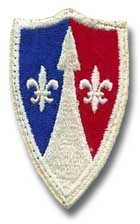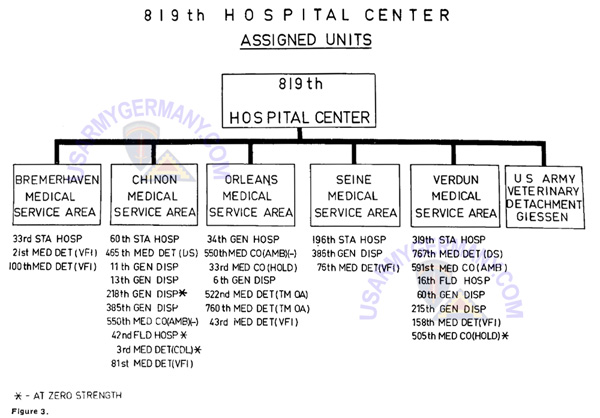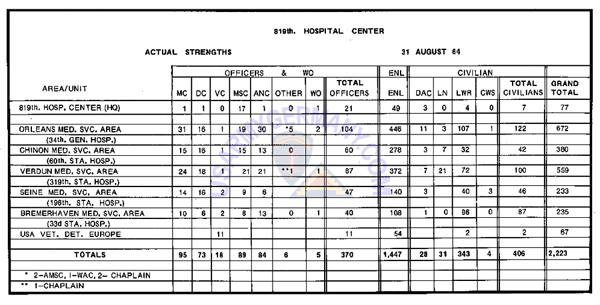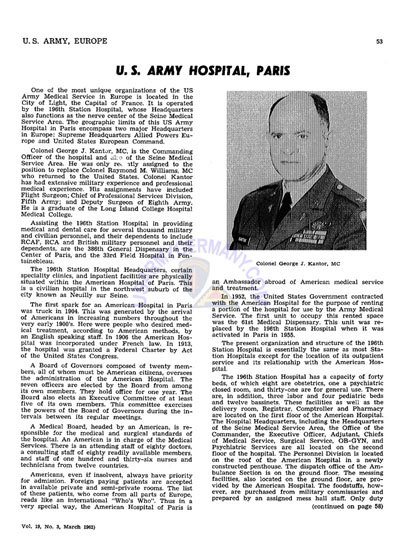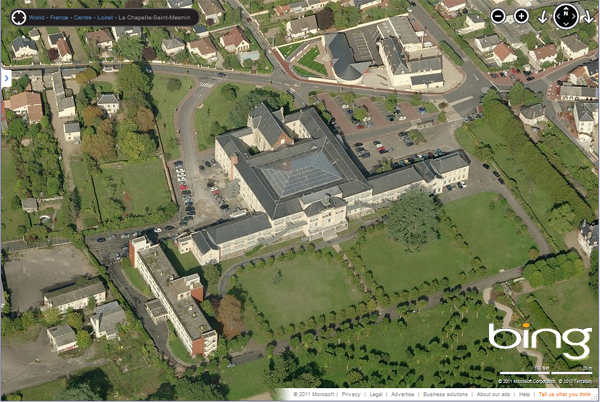| If you do
NOT see the Table of Contents frame to the left of this page, then
Click here to open 'USArmyGermany' frameset |
||||||||
|
US Army Communciations Zone, Europe |
||||||||
|
|
||||||||
|
||||||||
|
|
||||||||
| 819th Hospital Center | ||||||||
| 1964 | ||||||||
| (Source: USAREUR Medical Bulletin, Jan-Feb 1975) | ||||||||
| The 819th Hospital Center by Colonel Herbert D. Edger, MSC (**) This presentation will be in two parts. The first part, encompassing the peacetime mission of the 819th Hospital Center, is unclassified. The second portion, dealing with the emergency mission is classified secret. (Editor's Note: The classified portion is deleted.) For the benefit of the newer arrivals to the theater, I would point out that the 819th Hospital Center, with headquarters at Harbord Barracks, six miles south of Orleans, France, has been operational for the short span of two years plus two months. Activated in July 1962, the center is organized along conventional staff organizational lines as shown in Figure 2. |
||||||||
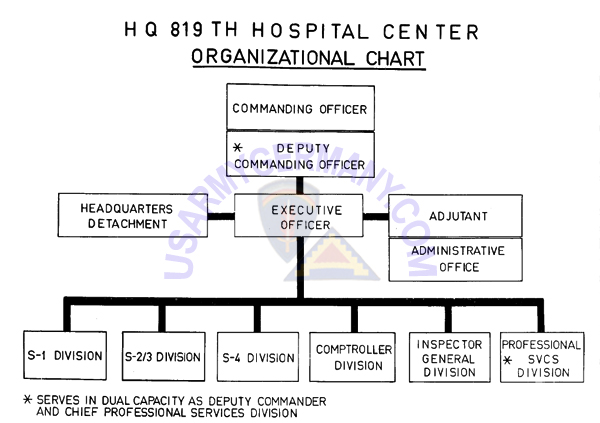 (Fig. 2) Organizational chart of the 819th Hospital Center Hqs staff (1964) |
||||||||
| As currently staffed. the Center does not have a Deputy Commander and the Commander doubles as Chief of Professional Services. A unique feature of our organizational structure is the fact that the Dental Surgeon and Staff Nurse are assigned to the 819th Hospital Center under Professional Services, and each wear two hats in serving in the same capacity on the staff of the USACOMZEUR Surgeon. The favor is returned as a consequence of having the Preventive Medicine Officer, Staff Veterinarian and Sanitary Engineer assigned to Medical Division, USACOMZEUR, serve in those capacities on the staff of the 819th Hospital Center. The remainder of the Center's staff carries out the prescribed functions for their respective areas of interest. The logistical and administrative support of units assigned to USACOMZEUR is accomplished by means of geographic areas of coverage assigned to area commands or depot complexes. Figure 3 shows these administrative areas. |
||||||||
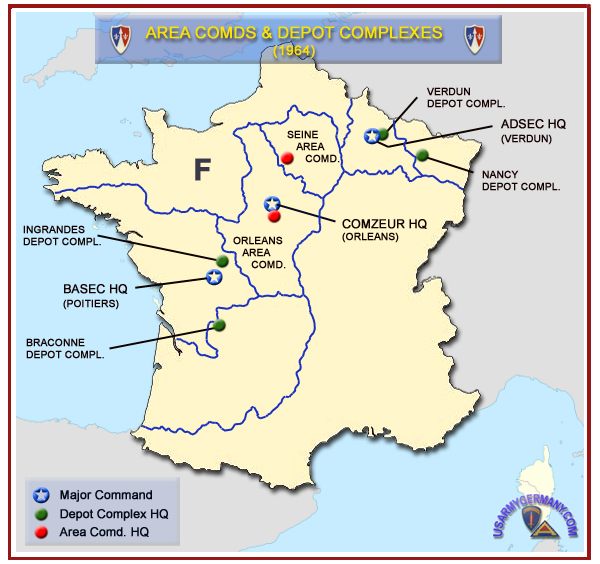 (Fig. 3) Geographic boundaries of area commands and depot complexes, 1964 (Original map modified by Walter Elkins) |
||||||||
| Here we note that support for Western France is divided between the Ingrandes General Depot complex to the north and the Braconme General Depot complex to the south. In the Center we have the Orleans Area Command to the south and the Seine Area Command to the north. The eastern portion of COMZ is administered by the Verdun and Nancy General Depot complexes. Not shown in Figure 3, because it lies within the Federal Republic of Germany and some distance north, is the US Army Terminal Command, Europe, which encompasses the port of Bremerhaven and which is an integral part of USACOMZEUR. In line with the provision of medical services throughout USAREUR, the USACOMZEUR area is divided into medical service areas (MSAs). The Chinon MSA, our largest in area and smallest in population served, supports generally the General Depot complex of Ingrandes and Braconne. The Orleans and Seine MSAs generally conform with their respective area commands with the exception that Fountainebleau, while located in the Seine Area Command, is included in the Orleans Medical Service Area. The Verdun MSA provides medical services for the Verdun and Nancy General Depot complexes and our Bremerhaven MSA, serves the USA Terminal Command, Europe. Figure 1 sets forth the units which comprise the troop list of the 819th Hospital Center along with their MSA attachments. Bremerhaven accomplishes all medical support through the 33rd Station Hospital and has, in addition, two Veterinary Food Inspection (VFI) units. The Chiron VISA, which I earlier described as having the largest geographical area, appears to have an extensive list of units. I hasten to point out that the units marked with an asterisk are at zero strength pending inactivation, and the others are maintained at a bare minimum. The Orleans MSA, with the greatest supported strength, is adequately staffed with personnel and units, as is Verdun, our second largest in population served. The Seine MSA is adequately staffed through the 196th Station Hospital, which operates in leased space in the American hospital of Paris, with its outpatient service at Camp Des Loges. A dispensary is also operated at SHAPE Headquarters by the 196th Station Hospital, while the 386th General Dispensary operates a dispensary at Rue Marboeuf in Paris. The US Army Veterinary Detachment, Giessen, is assigned to the Center, but operational control is retained by USACOMZEUR. |
||||||||
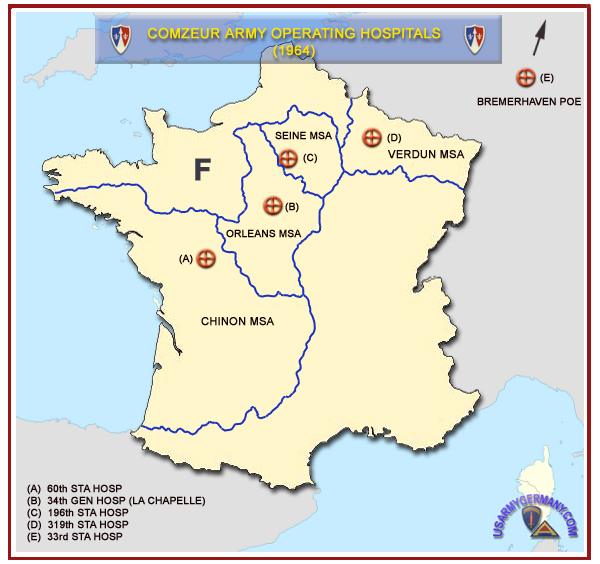 (Fig. 4) Operating hospitals under COMZEUR, 1964 (Original map modified by Walter Elkins) |
||||||||
| Figure 4 locates the five operating hospitals in USACOMZEUR. Starting at the left we have the 60th Station Hospital, with 35 operating beds, at Chinon. Next, our largest and the only specialty treatment hospital under the Center, the 34th General Hospital, with 125 operating beds, is at Orleans. The 196th Station Hospital in Paris is authorized 35 operating beds, and our second largest hospital at Verdun has 100. At the upper right of the chart and not in perspective is depicted the 33rd Station Hospital of Bremerhaven, operating an authorized 50 beds. In summary, for the area of USACOMZEUR, with a total population served of over 50,000, we operate 345 hospital beds. Our dispensaries are staffed with at least one full-time physician and necessary aidmen, and are considered reporting facilities for required outpatient reports. An aid point denotes those facilities provided with the services of a physician only part time, usually for conduct of regularly scheduled sick call. The spread of these facilities brings home the wide diffusion of our supported population. In France, medical support presents a constant struggle with the "Time and Trauma Gap," due to long distances and questionable roadnets from dispensaries to hospitals. By and large, where we have a dispensary operating, we have a dental clinic. Where we have an aid point, we use a circuit-riding Dental Corps officer to provide treatment. We have Veterinary Food Inspection detachments at Ingrandes, La Chapelle, Paris, Verdun, and two at Bremerhaven. In addition, we have a US Army Veterinary Detachment at Giessen, which was mentioned earlier. |
||||||||
| Our dispensaries operate in a very austere manner. This paucity of personnel is a result of the recently completed reduction of the line of communications for the US Army, Europe. Personnel reductions were administered across the board in USACOMZEUR, and the results speak for themselves. In the Chinon MSA, three of our dispensaries are manned by Labor Service physicians, and one part-time physician from Chinon covers Saumur. Three dispensaries have only one physician and there is only one Medical Service Corps administrative officer authorized in the area. In the Orleans MSA, the same picture of austere staffing is continued, while in the Seine MSA, we have an exception to my previous statement. Camp Des Loges operates the outpatient service of the hospitals, since no outpatient department is operated at the hospital per se. Thus, since the personnel involved can be identified as strictly out-patient-oriented, they are more numerous than in the other MSAs. In the Verdun area area the austerity is slightly alleviated, but changes in the original plan for reduction of the LOC lead us to believe that we will experience a population increase in this area, so that the advantage will be offset. In summary, we present the actual assigned strength, by MSA, for the 819th Hospital Center (Figure 5). We are quite proud of the accomplishments of the 2223 dedicated individuals who comprise the 819th medical team. The problems inherent in providing adequate medical care to large numbers of individuals scattered over a large area are well known. We feel we are doing a more than adequate job of it. The medical care is provided. and the price tag is not high. We, conclude with a summary of programmed funding for the 819th Hospital Center for FY '64-'65. As a result of the reductions in USACOMZEUR of some 6000 personnel, we have had to accept a reduction of some 347,900 dollars in our annual funding. This reduction occurs in spite of an increase in our contractual costs for space and services in the American hospital of Paris. Since economy is the order of the day, we will bear our share. as do all of you, and get on with the job. |
||||||||
| (**) The presentation was originally held at the USAREUR Surgeon's Tenth Annual Conference held in Heidelberg, Germany, 1-2 October 1964. Col Edger was the commanding officer of the 819th Hosp Cen at that time. | ||||||||
| 1965 | ||||||||
| (Source: USAREUR Medical Bulletin, March 1965) | ||||||||
| Dental Activities, USACOMZEUR and 819th Hospital Center by Colonel John E. Jordan, DC (***) The 819th Hospital Center operates with Headquarters at Harbord Barracks, six miles south of Orleans, France. Activated in July 1962, the Center is organized along conventional lines. The Dental Surgeon is part of the Professional Services Division which is normally headed by the Deputy Commander of the Center. In addition, the Dental Surgeon acts as Dental Surgeon for USACOMZEUR as a concurrent duty. The logistical and administrative support of units assigned to USACOMZEUR is accomplished by means of geographic areas of coverage assigned to Area Commands or Depot Complexes. Support for Western France is divided between the Ingrandes General Depot Complex to the north and the Braconne General Depot Complex to the south. For Central France, control of the southern sector is assigned to the US Army Post, Orleans, and the northern sector to the US Army Post, Paris. The eastern portion of USACOMZEUR in France is administered by the Verdun and Nancy General Depot complexes (see Figure 3 in the article above on the 819th Hosp Cen). Far to the north in Germany lies the Port of Bremerhaven in which the US Army Terminal Command, Europe, operates as an integral part of USACOMZEUR. In line with the provision of Medical and Dental Services throughout USAREUR, the USACOMZEUR area is divided into Medical Service Areas. There are five Medical Service Areas (Chinon, Seine, Orleans, Verdun and Bremerhaven) with an Area Dental Surgeon assigned to each. Over-all supervision of the Dental Service is the responsibility of the Dental Surgeon. 819th Hospital Center and USACOMZEUR. Chinon MSA The Chinon Medical Service Area is the largest in area and smallest in population served, supporting the General Depot complexes of Ingrandes and Braconne. The unit providing the dental support in this area is the 465th Medical Detachment (Dental Service), with its headquarters at Poitiers. This unit originally operated clinics at Captieux, Braconne, Bussac, Fontenet, Rochefort, Croix Chapeau, Poitiers, Ingrandes, Saumur, Chinon, and St. Nazaire. With the realignment of the Line of Communications (LOC), its area has now been reduced to permanently-staffed clinics at Captieux, Ingrandes, Braconne, Poitiers, and Chinon. The clinics at Croix Chapeau and St. Nazaire are operated on an itinerant basis with a doctor and his assistant travelling from one of the other clinics to these stations one week out of the month. Orthodontia service is provided on the same type of itinerant basis by the Orthodontist from Orleans visiting Poitiers one week out of the month. Other cases requiring consultation with specialists are referred to the US Army Hospital at Orleans. To provide dental care in this area, which is approximately 100 miles wide by 300 miles long, the 465th Medical Detachment, a KJ unit, is authorized ten officers and 15 enlisted men. One of the clinics, that at Captleux, is staffed by a Polish Labor Service Officer and his Polish Labor Service assistant. Orleans MSA The Orleans Medical Service Area operates six clinics in the Orleans and Fontainbleau area. Clinics at Harbord Barracks, Foret d'Orleans, and the US Army Hospital, Orleans, are staffed by personnel assigned to the augmentation unit of the 34th General Hospital. Clinics at Saran Air Field and Coligny Caserne are staffed by KI teams, and the clinic at Fontainebleau is staffed by the 6th General Dispensary Augmentation. This dental service, which supports Headquarters USACOMZEUR and Headquarters US Army Element Allied Forces, Central Europe, is authorized 19 officers and 28 enlisted personnel. Dental Specialists provided in this staffing are qualified personnel in Oral Surgery, Periodontia, and Prosthodontia. The Fixed Prosthesis Department (Crown and Bridge) is being expanded and it is hoped to staff this service by an assigned OJT officer. Seine MSA The Seine Medical Service Area consists of two clinics: one at Camp des Loges and the other in metropolitan Paris on Rue Marbeuf. The dental personnel are authorized within the TD expansion of the 196th Station Hospital. This clinic supports US personnel of SHAPE, EUCOM, and the US Army Post, Paris. These clinics are authorized 12 officers and 16 enlisted men. Within this authorization, specialists in Prosthetics, Periodontia and Fixed Prosthesis (Crown and Bridge) are represented. Cases requiring consultation in other specialties are referred to the US Army Hospital at Orleans. Verdun MSA The Verdun Medical Service Area is supported by the 767th Medical Detachment (Dental Service), a KJ unit authorized 12 officers and 18 enlisted personnel. This unit operates clinics at Verdun Activity, Nancy Depot, Toul Depot, Jeanne d'Arc Caserne, Toul, Trois Fontaines Depot Activity, Vitry-le-Francois Depot, and Brienne-le-Chateau Activity. The clinic at Metz Depot was closed during the realignment of the LOC in 1964. A prosthodontist is assigned to the Verdun clinic, and other specialized support is provided by the US Army Hospital, Landstuhl. Bremerhaven MSA The only USACOMZEUR dental service located outside of France supports the Bremerhaven Medical Service Area. This service operates a clinic in the US Army Hospital, Bremerhaven. It is authorized three officers and three enlisted men. With the exception of orthodontia, specialty support for this area is obtained by referral to the US Army Hospital, Frankfurt. The orthodontist stationed at Frankfurt makes an itinerant visit to the dental clinic at Bremerhaven once a month. The Dental Surgeon, 819th Hospital Center, participates actively in reviewing and recommending equipment and supply improvements. Plans for expansion and modernization of clinics are also reviewed within this office. Preventive Dentistry Program The Preventive Dentistry Program is an integral part of all clinics. Each Area Dental Surgeon supervises this program at each clinic and the 819th Hospital Center Dental Surgeon provides over-all supervision of the program. The unstinted interest of all members of the command in the flourishing and dynamic program of preventive dentistry amply repays the professional staff far the many hours of instruction and treatment they have contributed. In conjunction with this clinical program of preventive dentistry, patient education is being carried to the troops in the Troop Information & Education programs and to school children through routine and timely lectures in the schools. The professional education program is considered as an integrated part of each clinic and is programmed on a regularly scheduled basis. In the small clinics the use of tapes, films, and journals assist in the program. More extensive programs are held at larger installaffons with visiting consultants cooperating with the assigned personnel. When possible, personnel stationed at outlying clinics are encouraged and do attend and participate in these broader programs. During the last year, the USACOMZEUR Regional Dental Activity operated by the 3rd Regional Dental Activity was closed, the unit inactivated, and the mission transferred to the 2nd Regional Dental Activity at Frankfurt. The supervision necessary to provide the best possible treatment to our patients in the ever-changing patterns of relocation and reorganization provides a stimulating challenge. The day-to-day effective utilization of personnel and facilities with the thought always present of expanded needs in an emergency requires continual review of plans and resources. |
||||||||
| (***) Dental Surgeon, US Army Communications Zone, Europe and 819th Hosp Cen, APO 09058 | ||||||||
| US Army Hospital Paris (a.k.a. American Hospital) | ||||||||
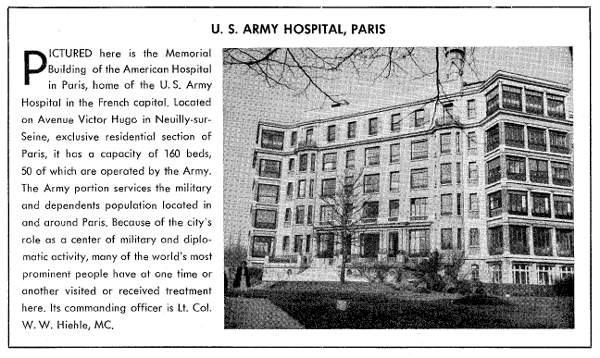 US Army Hospital in Paris (US Army, 1955) |
||||||||
| (Source: USAREUR Medical Bulletin, March 1962) | ||||||||
| (Source: USAREUR Medical Bulletin, February 1967) | ||||||||
| An article on "Nursing in the Paris Area" appeared in the Fenruary 1967 issue, just months before the US military pulled out of France (Operation FRELOC). (Click here to read the article.) |
||||||||
| US Army Hospital Fontainebleau | ||||||||
| (Source: USAREUR Medical Bulletin, October 1955) | ||||||||
 US Army Hospital in Paris (US Army, 1955) |
||||||||
| US Army Hospital La Chapelle (Orleans) | ||||||||
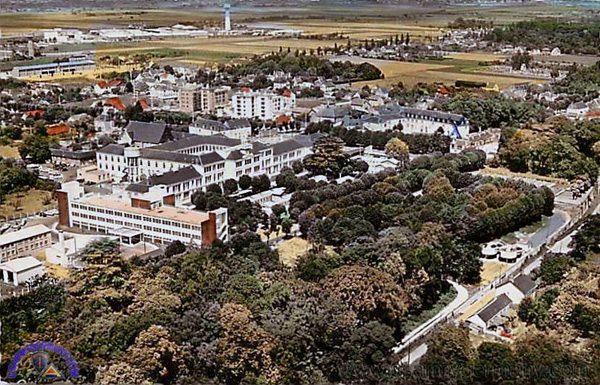 Former La Chapelle Army Hospital, after US forces left France (French postcard) |
||||||||
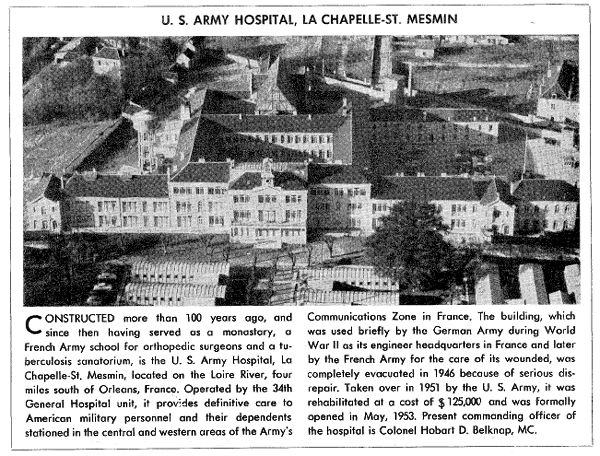 La Chapelle Army Hospital outside of Orleans, France (US Army, 1955) |
||||||||
| 1953 | ||||||||
| (Source: STARS & STRIPES, June 27 1953) | ||||||||
| The newly expanded 34th General Hospital in La Chapelle (Orleans) will open on July 8, 1953. The hospital is commanded by Col William A. D. Woolgar. It is staffed by 21 doctors, 33 nurses and about 500 enlisted men. The hospital has been moved out of prefabs into a completely remodeled building. Seven prefabs served as the hospital on the La Chapelle site since it was organized in 1951 as the 302nd Field Hospital. These buildings provided space for 75 patients. The prefabs will now become troop billets. The improved facility includes a new wing that connects two existing buildings and the latest in equipment. The expansion provides facilities for 250 patients and will end the need to evacuate major medical cases to US hospitals in Germany. Also included in the new building are a PX, post office and chapel. The mess hall can serve 500 persons at a time. An MP detachment will be assigned to the hospital. 50 French civilians are employed in the PX and mess hall and as building caretakers. Another recent development in efforts to improve medical services in Com Z has been the attachment of the 80th Hospital Train to the Orleans Area Command. The train will travel between Orleans and Com Z Base Section installations to evacuate patients to the 34th. |
||||||||
| 1960 | ||||||||
| (Source: Email from Peter B. Riesz) | ||||||||
| I was assigned to the 34th General Hospital as my first Army assignment. I had MOS 3200, General Medical Officer, as I had just finished my internship and joined under the Berry Plan. Flew from Fort Dix to Paris via the Azores in October 1960. Worked at the dispensary in Harbord Barracks in the AM running sick call. Worked in 34th Gen Hosp outpatient clinic in the PM. The most exciting time was when the Berlin Wall construction began in August 1961. Learned my little dispensary was a 100-bed hospital and we had to be ready for the evacuees from Berlin if that happened. Thankfully, it didn't. Worked the last year, 1962, in taking Obstetrics night call. Rotated home in August 1962 to enter a Radiology residency in San Antonio, Texas. |
||||||||
| 1962 | ||||||||
| (Source: USAREUR Medical Bulletin, April 1962) | ||||||||
| U.S. Army Hospital, Orleans Located near Orleans, France, the city made famous by Jeanne d'Arc, is the small village of La Chapelle-St. Mesmin. Here, in the beautiful Loire River Valley, the chateaux country of France, is the U.S. Army Hospital operated by the 34th General Hospital. The history of the building now housing the 34th begins with its construction in 1844 on the grounds of the Chateau de la Chapelle. The chateau, which was erected by Charles IX in 1584, is still standing and being used, although not by the hospital. The present day hospital was used as a seminary until the year 1905, when it was closed. The building remained unused until World War I, at which time it was re-opened as a hospital for war wounded. In 1918, it was converted into a 200-bed tubercular sanatorium and remained so until 1940. At the onset of World War II and the occupation of the Loire Valley by the German forces, the hospital was seized and turned into billets for Germain Engineer troops. Sometime in 1941, the French Government re-installed another military and tubercular hospital. In 1946 the building witnessed a complete evacuation, since many years of misuse left it in disrepair. Since 1950 the buildings and property have been occupied and greatly developed by the U.S. Army. The 302nd Field Hospital, the first U.S. Army unit to inhabit the old seminary, was replaced by the 34th General Hospital, in May of 1953. Since the arrival of the 34th at the old seminary, many improvements have been made, making the hospital in La Chapelle-St. Mesmin the largest U.S. Army General Hospital in France, serving all allied personnel throughout the Communications Zone. The 34th General Hospital is also the operating agent of the Orleans Medical Service Area, including Orleans, Fontainebleau and Paris. This area consists of seven medical units and eight dental clinics, which are operated by approximately 950 officers, enlisted men and women. A new wing, containing the most modern equipment and furnishings, was opened in August of 1960, which made it possible to improve and expand other medical and administrative sections housed in the main part of the hospital. The first floor of the new wing consists of an outpatient service, administrative and medical records rooms, an emergency room, eight examination rooms, a pharmacy, and an Ear, Nose and Throat Clinic. The OB-GYN Clinic on the second floor has examination rooms, an expectant fathers' waiting room, four labor rooms, and two delivery rooms. The Dermatology Clinic, plus a classroom and office for the Army Health Nurse, complete the floor. The third floor is composed of private and semi-private rooms totaling 24 beds, a full-view baby nursery, and a diet kitchen. The roof of the new wing contains a glassed-in sundeck, a roof garden, and the Language Laboratory. The main section of the hospital is made up of Headquarters and other administrative offices, X-Ray, Laboratory, the Medical Library, Post Office, Snack Bar, Mess Hall, and wards totaling 214 beds. Recreational facilities, which are offered to both the patients and duty personnel, include a movie theater, NCO and Specialist Club, Officers' Club Annex, softball diamond, tennis court, Special Services library, and the Red Cross Recreational Program, which is assisted by many of the local women's organizations. To enhance French-American relations, as well as Franco-American understanding in Public Health, the 34th has a French Intern Program. Through this program, graduates of French medical schools can take their internship at the hospital. The program followed is the same as that followed by the American Medical Association. The 34th General Hospital was formerly designated in 1917 as Base Hospital No. 34 at the Episcopal Hospital in Philadelphia, Pennsylvania. Its actual birth as a military organization took place on 7 September 1917, when it was officially mobilized under its present designation as the 34th General Hospital. The unit has previously served in France, England, Korea and Okinawa. In 1950, service in the Far East was interrupted when the unit was recalled to the States and inactivated. In 1952, the 34th was reactived and again ordered to Europe and has been here since. Col Karl D. MacMillan, MC, Commanding Officer of the Hospital and of the Orleans Medical Service Area, started his Army career in 1929. Prior to his assignment as Commander of the 34th General Hospital, he was the Chief of the EENT Section, Valley Forge Army Hospital. The hospital is fully accredited by the Joint Commission on Accreditation of Hospitals, and an institutional member of the American Hospital Association. |
||||||||
| US Army Hospital Chinon | ||||||||
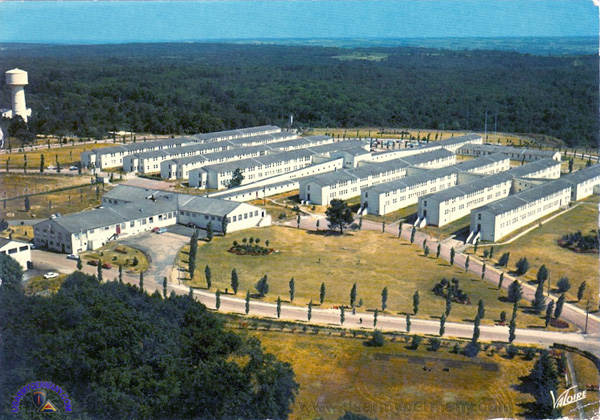 Former Army Hospital at Chinon, several years after US forces left France (French postcard) |
||||||||
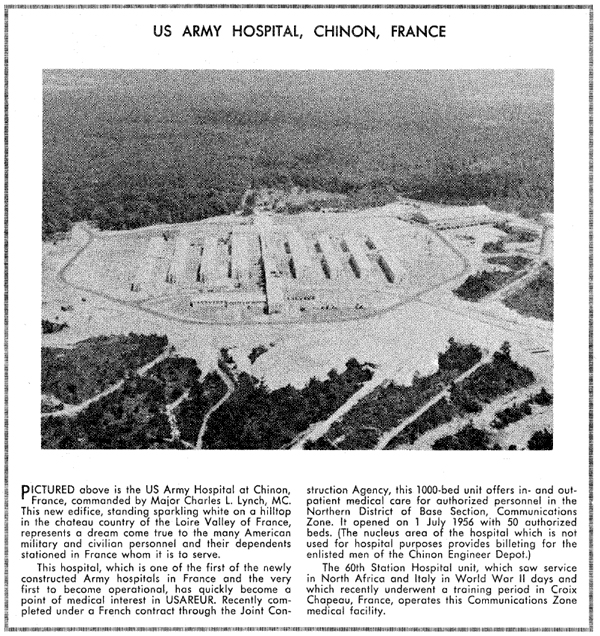 US Army Hospital Chinon (US Army, 1957) |
||||||||
| Related Links | ||||||||
